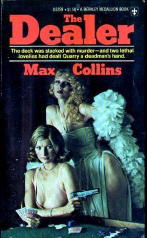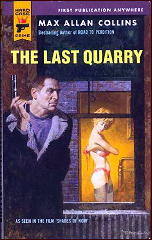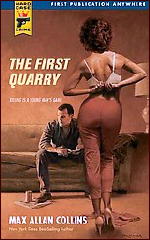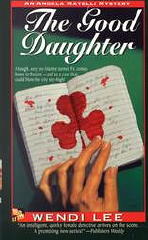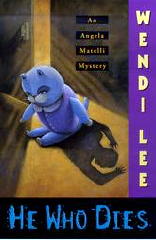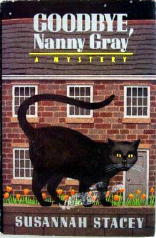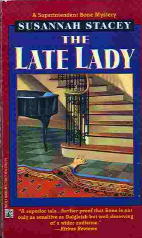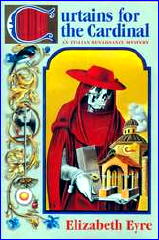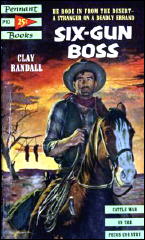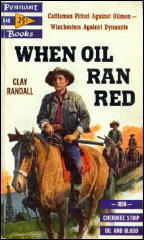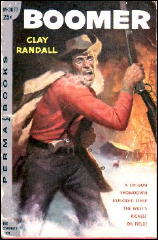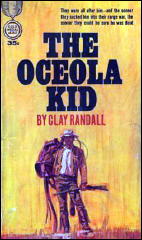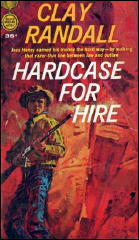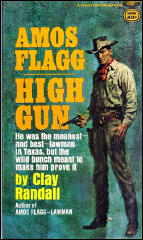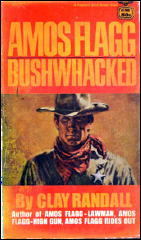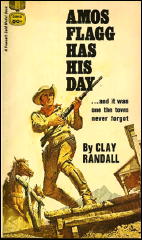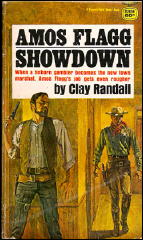March 2009
Monthly Archive
Tue 31 Mar 2009
A Review by MIKE TOONEY:
CHRISTIANNA BRAND – The Spotted Cat and Other Mysteries from Inspector Cockrill’s Casebook. Crippen & Landru, hardcover & trade paperback, November 2002. Edited by Tony Medawar.
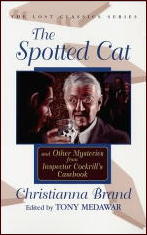
Christianna Brand’s Inspector Cockrill appeared in almost a score of novels, short stories, and even a play, most of which were published in her lifetime. Crippen & Landru have done us a service in preserving all of the short stories that saw publication — and more.
From the back cover blurb:
INSPECTOR COCKRILL INVESTIGATES
“Christianna Brand (the pseudonym of Mary Christianna Milne Lewis, 1907-1988) was a supreme mistress of the classic detective story, with twists and turns, and all the clues fairly given to the reader. The wizened, bird-like Inspector Cockrill of the Kent police starred in Green for Danger, one of the greatest detective novels to emerge from World War II, but The Spotted Cat is the first collection of all of the short stories about him. Five of the stories have never previously appeared in a Brand volume, and one of them is published here for the first time. The book also includes a genuine find, a previously unpublished three-act detective drama featuring Cockrill.”
* * * * * * * * * * * * * * *
CONTENTS:
Introduction (“In and Out of Darkness”) by Tony Medawar: A well researched article about Brand’s life and progress as a writer.
1. “Inspector Cockrill” (1978) by Christianna Brand: The author writes an amusing but affectionate biographical sketch of her most famous character, patterned closely after her father-in-law, a medical doctor.
“He [Cockie] is not one for the physical details of an investigation: ‘meanwhile his henchmen pursued their ceaseless activities’ writes his creator, not too sure herself exactly what those would be; and he is content to leave fingerprint powder and magnifying glass to the experts, using their findings in a process of elimination, to get down to the nitty-gritty from there on.
“He has acute powers of observation, certainly; a considerable understanding of human nature, a total integrity and commitment, much wisdom; and as we know a perhaps overlong experience of the criminal world …. Above all — he has patience.” True, “he will have compassion for the guilty”; nevertheless, “he can be forthright and stern …. There is no false sentiment about Chief Inspector Cockrill, none at all.”
2. “After the Event” (from Ellery Queen Mystery Magazine, January 1958 as “Rabbit out of Hat”)
In a famous play by Shakespeare, Othello strangles his (reputedly) faithless wife; back in the 1920s, an actor playing Othello at the time apparently did the same thing in the lady’s dressing room backstage. An unnamed Great Detective reminisces about the case to a group of acquaintances, among them Inspector Cockrill, who predictably pokes holes in the speaker’s handling of the situation, much to the Great Man’s chagrin. And one should always remember, as Cockrill does, that theatrical people have been known to put on an act ….
Note: Inspector Cockrill, cracking walnuts and irritating the Great Man, is an armchair detective in this story.
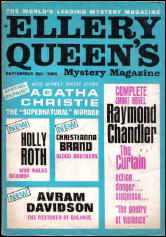
3. “Blood Brothers” (from EQMM: September 1965)
Brotherly love, like all relationships, seems to have its limits. Two siblings, identical twins, have been with the same girl, competing for her affections; but now, it seems, she is pregnant by one of them. The situation is further complicated by several factors: The girl knows that one of the brothers has killed a small boy in a hit-and-run; she is also married to a huge brute doing time in one of HM’s prisons but due soon for release; and one of the siblings harbors enough hatred to let the other take the fall for first-degree murder.
Inspector Cockrill — who enters in the last third of the story — simply lets things take their natural and inevitable course, as David and Jonathan rapidly degenerate into Cain and Abel … with a twist.
Note: Instead of being told in the third person, this story is narrated by one of the brothers.
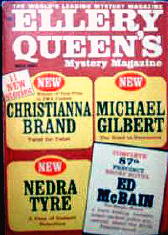
4. “The Hornet’s Nest” (from EQMM: May 1967 as “Twist for Twist”)
When wealthy Cyrus Caxton — a nasty piece of work, that one — does a Brodie face first into his half-eaten peach, no one of his acquaintance is moved to shed a tear, save his attractive wife. Inspector Cockrill is called in and confronts a fine set of likely suspects; in the end, the Inspector, Ellery Queen-like, has proposed two plausible solutions before pouncing on a third, actual one.
Elizabeth comments on Cockie’s method: “He’s — he’s sort of teasing us; needling us, trying to make us say something.” Presciently, the Inspector early in his investigation remarks: “There has been a plan here, doctor: no simple matter of a lick of poison scraped out of a fortuitous tin, smeared on to a fortuitous peach-in-liqueur; but a very elaborate, deep-laid, long-thought-out, absolutely sure-fire plan.”
5. “Poison in the Cup” (from EQMM: February 1969)
CASE HISTORY: Stella Harrison is a small-town doctor’s wife more than a little bored with her lot in life; her husband Richard, a painfully honest individual, seems oblivious to her incipient disaffection — and equally unaware of her secret love for his partner, Frederick Graham. A nurse at the hospital, Ann Kelly, however, makes no secret of her undying love for Stella’s husband… Ann makes a fatal mistake, though, when she decides to stage a bogus suicide attempt in Dr. Harrison’s surgery …. DIAGNOSIS: Murder. PROGNOSIS: Life in prison for a killer who remembers every detail but one ….
Note: The murderer’s identity is never in doubt; we see the crime committed. The interest lies in how Chief Inspector Cockrill, a la TV’s Columbo, will trip up the perp — because this killer uses the truth as a cover.
6. “The Telephone Call” (from EQMM: January 1973 as “The Last Short Story”)
The best-laid plans do often go off the tracks, don’t they? A young man short of money conceives an intricate plot to acquire a lot of it in a hurry; his girlfriend half-jokingly suggests it: “You’ll have to murder your rich Aunt Ellen”; and he improves it: “Yes, and let Cousin Peter swing for it; if he did, I’d scoop the lot.”
And so he carefully begins building two alibis, one for himself and a negative one for the hapless Peter… And it all works beautifully — except for one thing, and you don’t have to be Detective Inspector Cockrill to figure it out.
Note: The bulk of this story is told in the form of a written confession.
7. “The Kissing Cousin” (from Woman: June 2, 1973)
Cranky old Aunt Adela has millions, but true to form she is parsimonious and secretive about her wealth; her niece Franca doesn’t really care if she inherits — but there’s someone she knows who is greatly interested in the old lady’s money, someone willing to kill for it. When Aunt Adela is found dead, her house ransacked for a missing will, Chief Inspector Cockrill zeroes in on Franca: “You inherit,” he says. “And you hold the only key to the door.” But the killer already has Franca marked for murder, and knows as well the secret Keeper, the cowardly mastiff, is harboring ….
Note: It seems Cockie doesn’t really solve this one, and takes no active part in apprehending the murderer; he is a secondary character here.
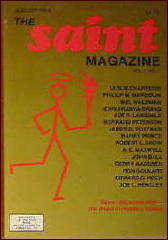
8. “The Rocking-Chair” (from The Saint Magazine: August 1984)
Taking a break from a village fete “on a boiling hot afternoon” to have “a little booze-up”, the Duchess of St. Martha’s Island retires to her castle with Miss Maud Trumble, “rich and famous author of dozens of really quite terrible books”, and Chief Inspector Cockrill.
Seemingly gripped by a feeling of guilt, Miss Trumble, “mildly squiffy,” relates her involvement in the unresolved Case of the Three Dead Ladies: “three women lying dead, spread out like a trefoil clover-leaf, their poor heads forming the centre point…” Cockie and the Duchess both prove able armchair detectives by “solving” this fifteen-year-old case.
“It was like a detective story, thought the Duchess, where the clues are placed not so much squarely before the reader as slightly obliquely, so that they come out as not quite what in fact they are.” Just so.
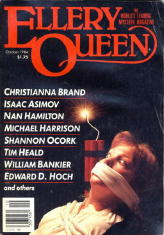
9. “The Man on the Roof” (from EQMM: October 1984)
English village life is normally uneventful, but not today: The much-despised and suicidal Duke of Hawksmere seems at long last to have followed through with his oft-delayed promise to do himself in: “a good, straight-forward suicide,” thinks Chief Inspector Cockrill, “heralded by the gentleman himself….”
If only it were that simple. The dearly deceased, consistent with the burdensome pattern of his life, has managed to die under most perplexing circumstances that suggest he was murdered; to wit, he seems to have expired in a classic “locked room.”
Cockie, in frustration, says: “The locked room is the lodge, locked in, as it were in all that untrodden snow. A man dead in the lodge, very recently dead, death instantaneous, from a gun-shot wound at close range. And the mystery is very easy to state and not at all easy to answer. The mystery is — where is the gun? — because it isn’t lying there close to his right hand where it ought to be, and it isn’t anywhere else in the lodge and it isn’t anywhere outside in all the snow.”
As in “The Hornet’s Nest,” Cockie devises two plausible scenarios — but the actual solution, one not of his devising, comes as an exasperating — and exasperatingly simple — surprise to both him and the unsuspecting reader.
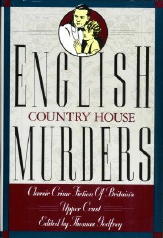
Note: “The Man on the Roof” can also be found in Thomas Godfrey’s English Country House Murders, 1989.
10. “Alleybi” (“This story, published in this volume for the first time, was probably written in the mid-1950s.”)
A short-short story (one and a half pages) that should serve as a warning to all investigating officers not to get tunnel vision whenever someone’s alibi is in doubt.
11. “The Spotted Cat: A Play in Three Acts” (“Previously unpublished; written in 1954-1955. Brand considered turning it into a novel but abandoned the idea.”)
Things aren’t going particularly well for barrister Graham Frere these days: His legal prowess is failing, he’s experiencing problems with alcohol, and he is beginning to think he’s going crazy.
At first he doesn’t realize that not all of his troubles are of his own making, that people close to him — under his very roof — are subtly pushing him towards madness, or possibly suicide; they have already murdered once, however, so even that option isn’t off the table. The conspirators themselves share a love-hate relationship, as evidenced by one telling the other:
“We’re bound together for ever now, you and I.”
“Nothing binds us.”
“Fear binds us.”
“It doesn’t bind me.”
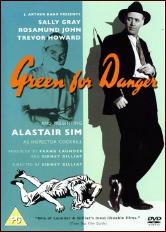
and: “When I look at you — coldly and sanely — I’d as soon put my love and trust in a cobra.”
Nice people! But the conspiracy falters when the worm turns and murder is prescribed ….
This play is a mixture of Gaslight and Double Indemnity with just a dash of Patricia Highsmith. Brand spoofs herself in one exchange:
“London Particular was a book — that woman who wrote Green for Danger.”
“I know it was. I couldn’t read a word of it.”
Despite a few typos (e.g., “does” for “dose,” “desert” for “dessert”) and some problematic punctuation, this book can be highly recommended.
Tue 31 Mar 2009
A 1001 MIDNIGHTS Review
by Ed Gorman:
MAX COLLINS – The Broker. Berkley, paperback original, 1976. Paperback reprint: Foul Play Press, 1985, as Quarry.
In the mid-1970s, the multi-talented Max Collins (who also writes as Max Allan Collins) produced a series of four paperback originals about a Vietnam vet turned hired killer, known only as Quarry. The Quarry series has so often been referred to as a Richard Stark pastiche that its own tone and morality are often overlooked.
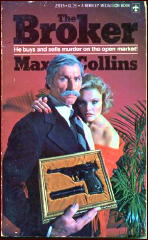
In The Broker, the first in the series, we meet Quarry shooting a man in an airport men’s room. Quarry’s assignment is to bring what the man is holding (heroin) back to his employer, an icy sort called the Broker. Quarry complies.
After complaining that he does not like to deal in drug killings, he reluctantly takes another Broker assignment, this one working with a homosexual killer named Boyd. In the rest of the novel, Collins shows us an abundantly unpleasant world peopled with all sorts of characters, from cuckolded husbands to porno-crazed geezers who look like Gabby Hayes.
What gives the Quarry books their style is the detached voice of the narrator: Quarry has no compunctions about killing people, because he feels most of them are rather foolish beings anyway. Unlike Stark’s Parker, who is human only when it serves his ends, Quarry is subject to feelings other than anger-melancholy, amusement, contempt-feelings he notes, nonetheless, with the kind of removed observation one would expect from a man in his profession.
The Broker and the other three novels in the series — The Broker’s Wife (1976), The Dealer (1976), and The Slasher (1977) — are successful for another reason: They depict the waning hippie/flower-power days with a great deal of historical accuracy. The Quarry books are therefore an important part of the crime fiction of the Seventies — a quirky, idiosyncratic look at the Midwest during the Gerald Ford regime.
———
Reprinted with permission from 1001 Midnights, edited by Bill Pronzini & Marcia Muller and published by The Battered Silicon Dispatch Box, 2007. Copyright © 1986, 2007 by the Pronzini-Muller Family Trust.
Bibliographic data: The Quarry series [Updated].
The Broker. Berkley, pbo, 1976; aka Quarry, Foul Play, 1985.
The Broker’s Wife. Berkley, pbo, 1976; aka Quarry’s List, Foul Play, 1985.
The Dealer, Berkley, pbo, 1976; aka Quarry’s Deal, Foul Play, 1986.
The Slasher, Berkley, , pbo, 1977; aka Quarry’s Cut, Foul Play, 1986.
Primary Target. Foul Play, hardcover, 1987.
Quarry’s Greatest Hits. Five Star, hc, 2003. Contents:
● Primary Target (novel)
● “A Matter of Principle” (short story, reprinted from Stalkers, Roc/Penguin, 1992, Ed Gorman, ed., and the basis for a short film included in the DVD boxed set Max Allan Collins Black Box Collection: Shades of Neo-Noir, 2006.)
● “Quarry’s Luck” (short story reprinted from Narrow Houses: Blue Motel, Volume 3, Little Brown, UK, 1994, Peter Crowther, ed.)
● “Guest Services” (short story reprinted from Murder Is My Business, Signet, 1994, Mickey Spillane & Max Allan Collins, eds.)
The Last Quarry. Hard Case Crime, pbo, 2006. Expansion of “A Matter of Principle,” and the basis for the feature length film, The Last Lullaby (2008).
The First Quarry. Hard Case Crime, pbo, 2008.
Quarry In The Middle. Hard Case Crime, pbo, 2009. (Forthcoming, November.)
Tue 31 Mar 2009
In case you missed it, there’s been a good deal of discussion in the comments following Mike Nevins’ most recent column about the possibility that Jack Vance wrote all, most or some of Ellery Queen’s Face to Face (NAL, 1967).
Mike Doran asked the question, but the possibility was first raised by George Kelley on his blog, which I recommend to you for all sorts of good reasons, including not only sound and solid discussion of books and music of all kinds, but for an abundance of cover art as well.
My own opinion regarding Face to Face, though, after reading all of the arguments, pro and con? George presents a good but non-conclusive case, but the door’s hardly closed on the matter. The possibility’s still there.
Mon 30 Mar 2009
WENDI LEE – Habeas Campus. Worldwide; paperback reprint, February 2003. Hardcover edition: St.Martin’s Press, 2002.
This one was a disappointment, to put it as mildly as I can. Wendi Lee, also a writer of westerns, is the author of four other mysteries about her Boston-based private eye Angela Matelli, so this drab and unbelievable outing came as quite a surprise, if not an out-and-out shocker.
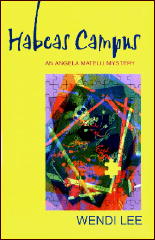
It might be the subject matter. Here’s the first line: “If my family had known that I was going up to Vermont to fight zombies, they would have slapped me in an institution so fast it would have made my head spin.”
There’s a lot of scientific talk in the book about Haitian poisons and antidotes to back up the premise that zombies (the walking undead) indeed do exist, but if you were to check it out on Google, you’d soon discover that the evidence is largely anecdotal and (to say the least) extremely controversial.
In any case, Lee’s job was to convince me that people can be transformed into zombies, and that they could be put to work in sweatshops or behind the counters at McDonalds. (You’re kidding me, right?) She also wanted me to believe that a body could somehow go missing from a college town’s morgue without a huge outcry being made. Just a prank by some fraternity kids? I don’t think so.
I also thought that the plan for Angela Matelli, an ex-Marine and nearly 30, to go undercover as a student at Hartmore College, living in an undergraduate dorm, registering just before midterm, was, well, rather uninspired (if not highly unlikely).
The writing is hardly better. Two paragraphs on page 16 say exactly the same thing. The dialogue is bad. From page 31: “This is why I didn’t tell you everything over the phone. I knew you would jump to the conclusion that this is some sort of weird situation.” On page 40, another two paragraphs (concerning Matelli’s phoney registration as a student) repeat themselves.
Back in her own stomping grounds, surrounded by family and friends, Angie Matelli’s basic perkiness and good nature might come off to greater advantage. They don’t here, I’m sorry to say.
— March 2003
[UPDATE] 03-30-09. For more on Angela Matelli and some more on the other books by her creator, Wendi Lee, you might check out the former’s data page on the Thrilling Detective website. Habeas Corpus was her last appearance in print.
Based on both the Revised Crime Fiction IV, by Allen J. Hubin, and her dossier on Kevin Burton Smith’s website (above), here’s her complete bibliography:
ANGELA MATELLI. [Wendi Lee]
Novels:
The Good Daughter. St. Martin’s 1995.
Missing Eden. St. Martin’s 1996.
Deadbeat. St. Martin’s 1999.
He Who Dies. St. Martin’s 2000.
Habeas Campus. St. Martin’s 2002.
Short stories:
“Salad Days” (Noir, Winter 1994)
“The Disappearance of Edna Guberman” (Murder For Mother, 1994)
“Check Up” (Lethal Ladies, 1996)
“The Other Woman” (Vengeance Is Hers, 1997)
Mon 30 Mar 2009
Posted by Steve under
ReviewsNo Comments
REVIEWED BY WALTER ALBERT:
JASPER FFORDE – The Fourth Bear. Viking, hardcover, August 2006; Penguin, trade paperback, July 2007.
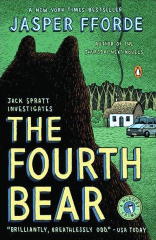
The second in the Nursery Crime series featuring DCI Jack Spratt and DS Mary Mary [after The Big Over Easy (2005)] finds Jack once again on the outs with his superiors and sidelined while a clueless detective investigates the escape from prison of the murderous Gingerbreadman, whose capture was one of Jack’s early successes.
In spite of warnings not to involve himself, Jack seems to keep running into the Gingerbreadman as he looks into the disappearance and subsequent murder of “Goldy” Hatchett after she escapes from a confrontation with the three bears in their rural retreat, and a series of mysterious explosions and deaths of cucumber growers that may somehow to linked to secret experiments of interest to the mammoth and slightly sinister QuangTech industries.
This may strike some readers as terminally cute, but I thought it was funny and a compulsive page-turner, with the important role played by the bear community further insuring my enjoyment of the goings-on.
Sun 29 Mar 2009
This isn’t a review of the book in the title of this post, Blast to Oblivion, by Chap O’Keefe, but I do want to tell you a couple of interesting things about it. You can find a much more lengthy write-up in the most recent online edition of Black Horse Extra, the March-May 2009 issue, in fact.
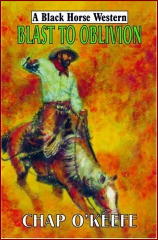
Each issue is devoted to the westerns published in the UK by Robert Hale, Ltd., and this issue is chock full of tidbits about the current quarter’s group of authors and their pen names, but there is also a sad note at the end in which the life and death of one of Black Horse’s more prolific western writers, Walt Masterson, is covered.
You may recognize Chap O’Keefe’s name as someone who frequently leaves comments on this blog, sometimes under that moniker and sometimes as Keith Chapman, which happens to be his real one.
Talking about his book, however, Chap says:
“The first words in this book, after the title pages, are written by Sir Arthur Conan Doyle: ‘The old wheel turns, and the same spoke comes up. It’s all been done before, and will be again.’
“Black Horse Western readers who are also Sherlockians will recognize that quotation as words spoken by Sherlock Holmes in the second chapter of The Valley of Fear. The Holmes novel was serialized in Britain in The Strand magazine between September 1914 and May 1915. Along the way, the George H. Doran Company, of New York, gave it a first book publication on February 27, 1915.”
There is much more to Chap’s essay, which goes into great detail about Sherlock Holmes, Sherlock Holmes movies, the Pinkerton Detective Agency, the Mollie Maguires, and every point you can think of in between, including his own book, Blast to Oblivion. Highly recommended!
Sun 29 Mar 2009
SUSANNAH STACEY – Body of Opinion.
Pocket Books; paperback reprint. First printing, March 1991. Previously published in the US by Summit Books, hardcover, February 1990. Prior UK hardcover edition: Bodley Head, 1988, as by Jill Staynes & Margaret Storey.
There is a mystery here – and one for which I do not know the answer – and that is why the books written by this pair of British authors appeared under their own names in the UK, but as by a pen name in the US. I haven’t any idea why.
But since both authors are now in their late 70s or early 80s, and no books by them under any byline have appeared in over ten years, I think it’s safe to assume that their entry in the Revised Crime Fiction IV, by Allen J. Hubin, is now complete:
STACEY, SUSANNAH. Pseudonym of Jill Staynes & Margaret Storey; other pseudonym Elizabeth Eyre.
Goodbye, Nanny Gray (n.) Summit 1988; UK: Bodley Head, 1987 as by Jill Staynes & Margaret Storey.
A Knife at the Opera (n.) Summit 1989; UK: Bodley Head, 1988 as by Jill Staynes & Margaret Storey.
Body of Opinion (n.) Summit 1990; UK: Bodley Head, 1988 as by Jill Staynes & Margaret Storey.
Grave Responsibility (n.) Summit 1991; UK: Bodley Head, 1990 as by Jill Staynes & Margaret Storey.
The Late Lady (n.) Pocket Books 1993; UK: Barrie, 1992 as by Jill Staynes & Margaret Storey.
Bone Idle (n.) Pocket Books 1995; UK: Century, 1993 as by Jill Staynes & Margaret Storey.
Dead Serious (n.) Pocket Books 1997; UK: Headline, 1995 as by Jill Staynes & Margaret Storey.
Hunter’s Quarry (n.) Pocket Books 1998; UK: Quarry (Hale 1999), as by Jill Staynes & Margaret Storey.
As long as Elizabeth Eyre has been mentioned, though, here’s a list of the books the two authors wrote under that name:
EYRE, ELIZABETH. Pseudonym of Jill Staynes & Margaret Storey
Death of a Duchess (n.) Headline 1991; Harcourt, US, 1992.
Curtains for the Cardinal (n.) Headline 1992; Harcourt, US, 1993.
Poison for the Prince (n.) Headline 1993; Harcourt, US, 1994.
Bravo for the Bride (n.) Headline 1994; St. Martin’s, US, 1995.
Axe for the Abbot (n.) Headline 1995; St. Martin’s, US, 1996.
Dirge for a Doge (n.) Headline 1996; St. Martin’s, US, 1997.
The Eyre books all take place during the Italian Renaissance; the leading character in each is a fellow named Sigismondo, who quoting from Publishers Weekly is a “brilliant deductionist [who] is bald like a monk but who fights like a soldier, and his slack-jawed manservant, Benno, who has an air of ‘amiable idiocy.’”
That’s a description that makes me want to read these book right away, and if you think I’m joking around when I say that, then you don’t know me very well.
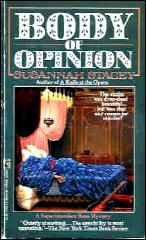
To the book at hand, though, the third in the series. It’s not clear to me that Superintendent Bone works for Scotland Yard or if he’s only a member of the local police force, but when a murder occurs at a party at a famous rock singer’s mansion, he’s the first to be called in. (One passing reference, on page 29, suggests that this is not the first time he’s met Ken Cryer and his son Jemmy, so that makes me believe he’s local.)
Dead is a woman with a deeply held secret, and since this time the writer who wrote the blurb for the back cover doesn’t mention it, I won’t either, except to say two things — the first being that part of this sentence is not exactly true, and the second that the secret just mentioned is NOT the list of blackmail targets that’s found later in the victim’s home.
What that does do is increase the number of possible suspects by a factor of at least ten — theoretically. Since it’s more than likely that the killer was seen at the party, invited or not, it’s still a matter of only dogged police work before his or her identity is uncovered.
One does hope for more, however, what with all of the clues, false leads, red herrings, misleading directions and crimes on the side that Bone and his crew must sort through. But alas, no, the ending is as straight (and flat) as a string.
Much more interesting is Bone’s home life, recently widowed with a young precocious young daughter to bring up on his own – but with the possibility of a new love in his life, a woman who is beginning at last to break down the emotional shields he’d set up after the auto accident took his wife away.
I think the two authors had the Golden Age of Detection in mind when they wrote this book, updated by all kinds of sexual activity that went unreported in mystery fiction of the 1930s. That’s the overall model they’re following at least, but if so, I can’t tell you that they succeeded — although it’s busy, the plot simply isn’t complicated enough.
On the other hand, the writing is excellent more often than not, with many a nice turn of phrase to complement the events taking place. The superintendent’s incipient love affair — deliberately chaste in comparison to the mystery itself, perhaps — may have been the even greater enticement for readers to be look for the next installment when it appeared.
Sat 28 Mar 2009
THE GOLDEN AGE OF BRITISH MYSTERY FICTION, PART II
Reviews by Allen J. Hubin.
Of Lynton Blow I know absolutely nothing. The “Moth” Murder (Alexander-Ouseley, 1931; Holt, 1932) and The Bournewick Murders (Butterworth, 1935) appear to be the only traces he left in our criminous world, and they betray a fondness for plotting complexities and apparent impossibilities.
Moth is perhaps the more interesting, and Bournewick the more baffling, though I found both quite pleasant British detection. In Bournewick Amelia Scott, an elderly though active woman living near the titular town, disappears; her strangled body turns up in due course. A suspect hoves into view, though the evidence is weakening; then he too is murdered.
Another killing follows, and the Yard arrives in the person of Inspector Eldridge, who must tie together the multiple and seemingly unrelated murders and a mysterious mailbox fire, while the bodies continue to pile up: six die violently in this tale. Blow does break one of the cardinal rules of detective fiction here, but I found Bournewick sufficiently good that I can forgive him; the final resolution, though fanciful and not really of the fair-play variety, ties all together neatly.
In Moth a burning plane crashes to earth near a coastguard station on Bournemouth Bay; the pilot, sole occupant, is burned to a crisp. Inquiries and an autopsy reveal that the victim is the famous airman, Charles Stafford, who took off with a female passenger (now vanished), and that the corpse died not of incineration but of a bullet in the brain.
Inspector Hunt of the Yard also has other puzzles: a second plane, piloted by the wife of Stafford’s passenger, took off at the same time and vanished without a trace –- and a policeman was murdered on a rural road not far from the Stafford crash site on the same night. And more: Stafford’s heir turns up at the dead man’s home, stays a night, then disappears; there seems to be a curious link with a London drug gang; and then there’s that suitcase full of money…
The U.S. dust jacket is criminally revealing, so avoid it, but not the book, which is fun 1930s reading.
Frass by John Chancellor (Hutchinson, 1929) was my first exposure to the work of this author, who produced a number of novels in our genre from 1923 to 1970. Frass is a thriller, not a detective story; I can’t speak for any other of Chancellor’s fictions.
Captain Frass left the sea, found a partner, and established a real estate business. But the captain was a bit naive: the residential plots his partner was peddling to earnest British burghers were just slightly offshore, and Frass spent a solo two years on the rockpile when the roof fell in.
Now released, he’s approached by Roscoe Lengarde and his Prisoner’s Benevolent Society with an offer of employment. Frass resists for a while, then joins in; Lengarde has a nice smuggling scheme going, using pleasure vessels.
Cracks rapidly develop in the operation, however: Frass discovers love, a conscience, a traitor in the ranks, and looming Excise men, in that sequence, and survival of the fittest becomes the order of the day. It will not surprise you to learn that the captain is quite fit (and survives for at least one sequel novel).
This is competent crime-adventure, enlivened more than anything else by its subsidiary characters: the sniveling and cowardly Ginger Hoyst, the reliable follower Taunton, and the mad historian Peterson.
NOTE: Go here for the previous installment of this column.
[EDITORIAL UPDATE.] 03-30-09. On the Yahoo “Golden Age of Detection” group, Juergen Lull points out that Lynton Blow’s The “Moth” Murder is available as an online etext at http://www.archive.org/details/mothmurder00blowiala.
On the same venue, Doug Greene follows up with a comment, saying: “The Moth book seems to have been based on the famous disappearance over the channel of Alfred Loewenstein in 1928 — Darwin Teilhet used the same background in his Death Flies High (1931). The story can be followed in William Norris’s [non-fiction account of the mystery] The Man Who Fell from the Sky.”
To this, Curt Evans adds the fact that Lynton Blow was a flight instructor, appropriately enough, verified by a search on Google and this page.
Sat 28 Mar 2009
ANTHONY ARMSTRONG and the JIMMIE REZAIRE Novels
by David L. Vineyard.
Anthony George Armstrong Willis (1897-1972) was a Canadian novelist and playwright best remembered today for his play Ten Minute Alibi and the novels The Room at the Hotel Ambre (also a play) and The Strange Case of Mr. Pelham (adapted for Alfred Hitchcock on television, and as the 1970 film The Man Who Haunted Himself, directed by Basil Deardon).
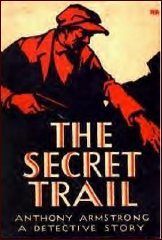
From 1927 to 1932, however, he penned five of the best thrillers from the heyday of the form about gentleman crook Jimmie Rezaire and his ‘secret service’ adventures in The Trail of Fear (1927), The Secret Trail (1929), The Trail of the Lotto (1930), The Trail of the Black King (1931), and The Poison Trail (1932).
In their A Catalogue of Crime Jacques Barzun and Wendell Hertzig Taylor said of The Trail of Fear, the first Jimmie Rezaire novel:
“Not strictly a detective story, but a good example of the chase after dope smugglers of the type popular in the late twenties … the chase goes on continuously for 275 pages, and it holds the attention surprisingly well … the hero is not a superman, and his strengths and weaknesses are well matched.” (page 37)
What sets the Rezaire novels apart from the adventures of Bulldog Drummond, Sydney Horler’s Tiger Standish, Wyndham Martin’s Anthony Trent, and the other colorful adventurers of the era was both Armstrong’s sense of drama and literacy and Jimmie’s character.
The slight, attractive Rezaire was no steel-thewed six-footer laying the enemy about him with a single blow, no brighter buccaneer or durable desperado, but a clever criminal who enjoyed the game of pitting his brains against the police until he allowed himself to be caught and served a term in the pen.
In The Trail of Fear he’s still a criminal and drawn into a bit of secret service work which suits his nature. In The Secret Trail, just out of prison, he teams up with his one time girl friend Vivienne and Harry Hyslop (aka H.H.), down from Oxford after a forgery scandal, who have been running a shop lifting scam. Jimmie opens a Private Inquiry agency and almost immediately gets drawn into yet another bit of secret service trying to rout a spy ring that has stolen the Murchison bomb sight and plans to smuggle it out of the country to Russia.
The books are primarily chase and pursuit, aided by Armstrong’s understanding of plot construction and the line of suspense. Unlike many writers of the period Armstrong doesn’t indulge in tiresome blathering and the silly ass dialogue that mars the Drummond books and others from this time frame.
The Rezaire books are a modern read, with Jimmie a more complex hero than most. Though he loves the game and plays to win he is also attractively human and given to doubts and concerns. He’s also apt to rely on his wits too much, which is where H.H. comes in as a good man with his fists and a gun. H.H. would be the hero of any other series of the era, but Armstrong is careful to show us the limit of the brawn-over-brains type when pitted against the kind of super criminals Jimmie and company cross swords with on a regular basis.
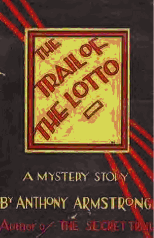
That said, the books are very much of the period they were written, with the usual foreign spies and drug smugglers (cocaine rings feature in many books of the era, from thrillers to classical detection like Sayers’ Murder Must Advertise), but all done with Armstrong’s superior writing and Rezaire’s more intelligent hero:
“He settled down to his food, but his brain was busy marshalling his information about the sighter. What had he definitely learned from the dead man’s shorthand note? A certain amount at any rate. He knew that there were three if not four men concerned. He knew that the bomb sighter was somewhere in London. He knew that because it was so complicated the secret was safe, and would remain so till it left the country for Paris, where the man Siminski would arrive on the 19th to take it to Russia. He knew that therefore he presumably had six days — for today was the 13th — six days during which the spies apparently had to make some arrangements for ensuring a departure without a hitch by the Calais route. Of course they might try to smuggle it out by means of a motor-boat or airplane, but the boldest way was always the best; a passport, a suitcase, and an innocent appearance would do the trick easily.”
That’s more reasoning and deductive work than in the entire Bulldog Drummond oeuvre. In fact, the fun is watching Jimmie as he thinks and fights his way out the various deadly traps set by the opposition and the chases in fast low slung cars, motor boats, airplanes, and on trains, across rooftops, down foggy roads, through busy London streets, and across the Channel in France.
Armstrong’s understanding of drama keep the books moving swiftly, while the plot unfolds in snappy dialogue and exposition. Here Jimmie’s ex-partner Long Sam is back from America and out to get Jimmie:
They stayed chatting with Viv in her sitting room for nearly an hour. Then the bell rang.
“Sam,” whispered Viv, and the pair were hustled into hiding. They found themselves concealed by a thick curtain which hung across a corner behind the sofa. The one big window of the room was just on the left.
“Don’t come out Jimmie, unless I call you,” pleaded Viv. “Honestly Sam won’t hurt me, but he might go for you if …”
“What about nice little me?” put in Hyslop humorously. “Don’t nobody love me too?”
“And you, H.H.,” added Viv, but something in her eyes told him he didn’t count beside Jimmie — that strange little man with so much ingenuity and so little physical courage.
It should be pointed out that Jimmie is hardly a coward, but having the wit and common sense to know when he’s in danger and the imagination to see what the consequences of his actions might be he’s no steely nerved ice man either. He’s cool and leveled headed in action, but has the good grace to at least sweat the details when he’s bound up in a rug being carried to meet his maker in the trunk of the villain’s speeding salon car.
For anyone interested in the thrillers of the era, the Armstrong books about Jimmie Rezaire offer a better than usual entry point forgoing the blather of the Drummond books, the bullying of Horler’s various heroes, and the gloating Berkeley Gray’s Norman Conquest was prone to.
While they don’t have the sheer spirit and joy of the early Saint adventures by Leslie Charteris, they are clever and fast-paced, and cinematic in the best sense. The jingoism, snobbery, casual racism, and other drawbacks of books of the time are played down, and the writing is crisp and literate without the endless false bon homme of so many of Armstrong’s contemporaries.
Jimmie Rezaire is a complex and interesting protagonist, and one who deserves to be better remembered. Among the armies of Blackshirts, Picaraoons, Gray Phantoms and the like, Jimmie was a breath of fresh air with well-conceived action and a fast pace that modern readers will appreciate, along with a more human and interesting set of heroes than the usual breed of supermen.
— All quotes from The Secret Trail (Macrae Smith, US, 1929).
Bibliographic data: [Taken from the Revised Crime Fiction IV, by Allen J. Hubin.]
REZAIRE, JIMMIE [Anthony Armstrong]
Jimmie Rezaire (n.) Paul, 1927. US title: The Trail of Fear. Macrae-Smith, 1927.
The Secret Trail (n.) Methuen, 1928. Macrae-Smith, 1929.
The Trail of the Lotto (n.) Methuen, 1929. Macrae-Smith, 1930.
The Trail of the Black King (n.) Methuen, 1931. Macrae-Smith, 1931.
The Poison Trail (n.) Benn, 1932. No US edition.
Fri 27 Mar 2009
CLAY RANDALL, aka CLIFTON ADAMS (1919-1971)
A Checklist:
Clifton Adams deserves a checklist and a page to himself, but that will have to wait for another day. One of his several pen names, however, was Clay Randall, and it was as the latter that he wrote a series of “Amos Flagg” westerns.
The latter came up recently in the comments following my review of one of the Buchanan books, a series also published by Gold Medal.
The Randall books are relatively scarce, but not very expensive. I’m surprised to see that I have only two of them, both in the Flagg series. Not having read any of them — a deficiency in myself that I will have to remedy soon — I’ll have to rely on James Reasoner’s comment, and I’m quoting: “The Amos Flagg novels are somewhat similar to [the TV series] Gunsmoke, as I recall, but only in the same sense that any town-set Western series with a lawman as the central character would be.”
Note that not listed here are a dozen or so western stories that Adams wrote as Clay Randall for the pulp magazines, perhaps more. The first two novels were published in hardcover; all of the others are paperback originals. Amos Flagg is the leading character in the last six.
Six-Gun Boss. Random House, hc, 1952. Pennant P10, pb, 1953. “A range detective works undercover to rid the range of rustlers.”
When Oil Ran Red. Random House, 1953. Pennant P48, pb, 1954. “A range war in the Cherokee Strip sets cattlemen against oilmen.”
Boomer. Permabook M3077, pbo, 1957. “An oil worker has to defend his rigs against crooks who have gunned his boss down.”
The Oceola Kid. Gold Medal s1342, pbo, 1963. Leisure, pb, 1974. “The kid is drawn into a range war.”
Hardcase for Hire. Gold Medal s1357, pbo, 1963. Belmont Tower, pb, 1974. “A bounty hunter travels to Choctaw country after a man he’s never seen.”
Amos Flagg — Lawman. Gold Medal k1482, pbo, 1964. Belmont Tower, pb, 1973
Amos Flagg — High Gun. Gold Medal k1596, pbo, 1965. Belmont Tower, pb, 1973. “Four notorious killers drift into Sangaree County.”
Amos Flagg Rides Out. Gold Medal k1677, pbo, 1967. Belmont Tower, pb, 1973.
Amos Flagg � Bushwhacked. Gold Medal d1760, pbo, 1967. Belmont Tower, pb, 1973.
Amos Flagg Has His Day. Gold Medal D1946, pbo, 1968. Belmont Tower, pb, 1973, as The Killing of Billy Jowett. “The town figures the sheriff is due some recognition on Amos Flagg Day.”
Amos Flagg — Showdown. Gold Medal D2098, pbo, 1969. Belmont Tower, pb, 1973. “A tinhorn gambler becomes the new town marshal.”
Next Page »








